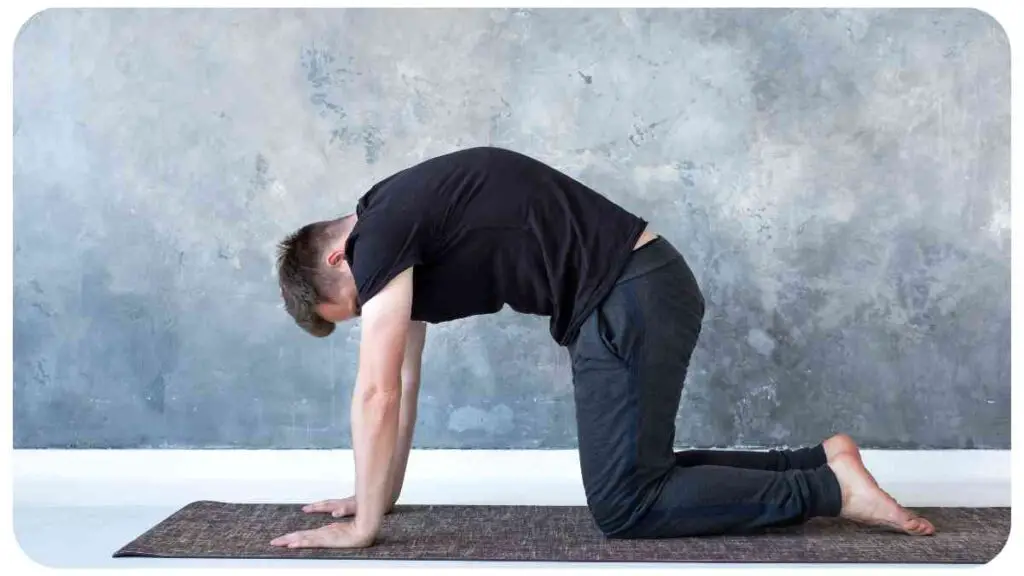Back pain is a prevalent condition that affects millions of people worldwide. It can be caused by various factors, including poor posture, muscle imbalances, repetitive strain, and even emotional stress.
Before delving into how yoga can help alleviate back pain, it is essential to understand the underlying causes and triggers.
| Key Takeaways |
|---|
| Practice yoga poses that specifically target the back to alleviate pain and improve flexibility. |
| Incorporate gentle stretching and strengthening exercises to support the muscles and spine. |
| Incorporate breathing techniques to enhance relaxation and reduce stress levels. |
| Modify and adapt poses to suit your individual needs, using props for support and comfort. |
| Practice mindfulness and meditation to reduce stress and cultivate a positive mindset. |
| Seek professional guidance if you experience severe or chronic back pain or other concerning symptoms. |
| Avoid common mistakes and injuries by practicing proper form, gradually increasing intensity, and listening to your body’s signals. |
| Maintain consistency in your yoga practice, gradually increasing the duration and intensity over time. |
| Track your progress, celebrate achievements, and seek inspiration from real-life success stories. |
| Review FAQs for additional information and guidance on practicing yoga for back pain. |
2. The Benefits of Yoga for Back Pain Relief
Yoga has gained recognition as an effective and holistic approach to treat back pain. Its combination of physical postures, breath control, and mindfulness has been shown to improve flexibility, strength, and overall well-being. Regular yoga practice can help reduce pain, increase mobility, and promote healing.
Yoga provides both short- and long-term benefits for back pain:
- Short-term benefits: Immediate relief from pain and tension through gentle stretching and relaxation techniques.
- Long-term benefits: Strengthening the muscles that support the spine, improving posture, and promoting a healthy spine for years to come.
Building a strong mind-body connection is essential for achieving spiritual enlightenment. Explore the transformative combination of yoga and meditation and unlock the serenity and clarity within.
3. Choosing the Right Yoga Poses for Back Pain

When practicing yoga for back pain, it is essential to choose poses that alleviate discomfort and promote healing. Different poses target specific areas of the back, providing relief and improving strength.
Table 1: Recommended Yoga Poses for Back Pain
| Yoga Poses | Targeted Area | Benefits |
| Child’s Pose | Lower back | Stretches and relaxes the lower back muscles |
| Cat-Cow Pose | Entire spine | Warms up the spine and increases spinal flexibility |
| Downward Dog | Hamstrings | Lengthens and stretches the hamstrings and back muscles |
| Bridge Pose | Lower back | Strengthens the lower back, glutes, and hamstrings |
| Sphinx Pose | Upper back | Opens and strengthens the upper back and shoulders |
Table 1: Recommended Yoga Poses for Back Pain (continued)
| Yoga Poses | Targeted Area | Benefits |
| Cobra Pose | Lower back | Increases flexibility in the back and strengthens the spine |
| Triangle Pose | Side body | Stretches and strengthens the side body, relieving tension and improving posture |
| Child’s Pose | Lower back | Provides deep relaxation and gentle stretching for the lower back |
| Pigeon Pose | Hips and glutes | Opens hips and stretches the glutes, relieving tension in the lower back and hips |
| Standing Forward Fold | Hamstrings | Lengthens and stretches the back of the legs and spine, promoting flexibility |
It is important to note that practicing yoga for back pain always varies from person to person. Some poses may be helpful for one individual while causing discomfort for another. Listen to your body and tailor your practice to suit your specific needs.
4. Preparing for Your Yoga Practice
Before embarking on your yoga journey to alleviate back pain, it’s crucial to prepare yourself physically and mentally:
- Consult with a healthcare professional: If you have a pre-existing back condition or chronic pain, seek guidance from a healthcare professional before starting any new exercise regimen.
- Create a safe yoga space: Set up a clean and clutter-free area at home where you can comfortably practice yoga. Use a yoga mat or non-slip surface to prevent injuries.
- Warm up your body: Prior to starting the yoga poses, warm up your muscles with some gentle stretches and movements. This will prepare your body for the practice and reduce the risk of strain.
- Gather any necessary props: Depending on your specific needs, gather any props that may aid your practice, such as blocks, bolsters, straps, or blankets. These props can provide support, stability, and comfort during various poses.
Relieve your back pain and restore your well-being with these effective yoga poses. Strengthen your core, improve flexibility, and experience lasting relief through the power of yoga.
5. Engaging Proper Alignment and Technique

Proper alignment and technique are key to ensuring an effective and safe yoga practice, particularly when dealing with back pain. By following these alignment tips, you can minimize strain on your back and maximize the benefits of each pose:
Table 2: Alignment and Technique Tips for Common Yoga Poses
| Yoga Pose | Alignment Tips |
| Mountain Pose | Stand tall with feet hip-width apart, engage core muscles, and gently lengthen the spine |
| Warrior II Pose | Keep the front knee aligned with the ankle, straighten the back leg, and elongate the torso |
| Plank Pose | Maintain a straight line from head to heels, engage the core, and avoid sagging or rounding |
| Tree Pose | Focus on a single point for balance, place the foot on the inner thigh or calf, avoid the knee |
| Corpse Pose | Lie flat on your back with legs extended, arms relaxed by your sides, and palms facing up |
By paying attention to these alignment cues, you can prevent unnecessary strain on your back and cultivate a safe and effective practice.
6. Breathing Techniques for Enhanced Back Pain Relief
Incorporating specific breathing techniques into your yoga practice can enhance the benefits for back pain relief. Deep, controlled breathing not only helps to oxygenate the body but also promotes relaxation and reduces stress levels. Here are some breathing techniques to complement your yoga practice:
Table 3: Breathing Techniques to Complement Yoga for Back Pain
| Breathing Technique | Instructions |
| Diaphragmatic Breathing | Breathe deeply into your belly, expanding it as you inhale and gently contracting it as you exhale |
| Ujjayi Breathing | Inhale through the nose, slightly constrict the back of the throat, and exhale audibly through the mouth |
| Alternate Nostril Breathing | Close your right nostril with your right thumb and inhale through the left nostril. Alternate sides |
| 4-7-8 Breathing | Inhale through the nose for a count of 4, hold the breath for a count of 7, and exhale through the mouth for a count of 8 |
By incorporating these breathing techniques into your yoga practice, you can create a deeper mind-body connection and enhance the relaxation response, ultimately contributing to back pain relief.
7. Modifying and Adapting Yoga Poses for Your Individual Needs
As you engage in yoga for back pain, remember that modifying and adapting poses is perfectly acceptable. Your body is unique, and what works for others may not work for you. Here are some tips for modifying poses:
- Use props: Utilize blocks, bolsters, or blankets to provide support and make poses more accessible.
- Reduce range of motion: If a pose causes discomfort, reduce the range of motion or perform a more gentle variation.
- Focus on alignment: Pay attention to proper alignment cues to protect your back and avoid strain.
- Take breaks when needed: Listen to your body and rest when necessary. Pushing through pain can lead to further injury.
By modifying and adapting poses to suit your individual needs, you can ensure a safe and enjoyable practice while still reaping the benefits of yoga for back pain relief.
Not only is yoga beneficial for the body, but it also holds surprising advantages for athletes. Discover how yoga can benefit athletes, enhancing performance, preventing injuries, and promoting overall well-being.
8. Incorporating Props for Extra Support and Comfort
Yoga props can be invaluable tools in your practice, especially when dealing with back pain. They provide additional support, enhance alignment, and increase comfort during poses. Here are some commonly used props for yoga:
Table 4: Recommended Props for Yoga Practice
| Props | Benefits |
| Yoga blocks | Assist with alignment, provide support, and help maintain balance in various poses |
| Yoga strap | Aid in achieving proper alignment, especially in poses that require deeper stretches |
| Bolsters | Enhance comfort and support in restorative poses, providing a gentle lift or cushioning effect |
| Blankets | Add padding and warmth during seated or reclining poses, ensuring comfort for sensitive areas |
Incorporating props can make your yoga practice more accessible, allowing you to engage in poses with greater ease and comfort, ultimately supporting your journey to relieve back pain.
9. Practicing Mindfulness and Meditation for Stress Reduction
Stress can exacerbate back pain, making it important to address both the physical and emotional aspects of discomfort. Mindfulness and meditation techniques can help reduce stress, promote relaxation, and cultivate a positive mindset. Here are some mindfulness and meditation practices to incorporate into your yoga routine:
Table 5: Mindfulness and Meditation Techniques for Back Pain
| Techniques | Instructions |
| Body scan | Close your eyes and mentally scan your body from head to toe, observing any sensations or tension |
| Loving-kindness meditation | Cultivate feelings of compassion and love for yourself and others, sending well wishes to all |
| Guided visualization | Imagine a peaceful place or visualize healing energy flowing into your body, focusing on relaxation |
| Mantra repetition | Choose a soothing word or phrase and repeat it silently or aloud, allowing it to calm your mind |
By regularly practicing mindfulness and meditation alongside your yoga practice, you can support your overall well-being, manage stress, and contribute to the healing process of your back pain.
10. Understanding When to Seek Professional Guidance

While yoga can offer immense benefits for back pain relief, it’s important to recognize when professional intervention may be necessary.
If you experience severe or chronic pain, numbness, tingling, or any other concerning symptoms, consult with a healthcare provider or a qualified yoga instructor familiar with therapeutic yoga. They can provide personalized guidance and ensure appropriate modifications for your condition.
Unlock the secret to a stronger and more flexible body with the practice of yoga. Find out how yoga can empower you physically, mentally, and spiritually, enabling you to transcend your limitations and achieve holistic wellness.
11. Avoiding Common Mistakes and Injury
To avoid exacerbating back pain or sustaining injuries during your yoga practice, it’s crucial to be mindful of some common mistakes:
- Avoid straining or forcing yourself into poses beyond your current ability.
- Listen to your body’s limitations and respect any discomfort or pain.
- Gradually progress in difficulty and intensity, avoiding sudden leaps.
- Always warm up before diving into more challenging poses.
- Seek guidance and observe proper form to ensure correct alignment.
By paying attention to these precautions, you can mitigate the risk of injuries and enjoy a safe, nourishing yoga practice.
12. Maintaining Consistency and Gradually Increasing Intensity
Consistency is key when practicing yoga for back pain relief. Engaging in regular sessions, even if they are shorter in duration, can yield greater benefits over time.
Start with a manageable routine that aligns with your schedule, gradually increasing the intensity and duration as your body adapts and becomes stronger. Remember, progress is a journey, and small, consistent steps lead to significant improvements.
13. Tracking Your Progress and Celebrating Achievements
Tracking your progress can be motivating and provide a sense of accomplishment throughout your journey. Take note of the changes you experience, such as increased flexibility, reduced pain, or improved posture. Celebrate your achievements, no matter how small, as they signify your commitment and dedication to your well-being.
For an in-depth understanding of different yoga styles, delve into the comparison between Yin Yoga and Hatha Yoga. Discover if you really need both practices and explore their unique benefits by reading our article on Yin Yoga vs. Hatha Yoga.
14. Real-Life Success Stories: From Back Pain to Yoga Bliss
It can be incredibly inspiring to hear real-life stories of individuals who have found relief from back pain through yoga. These stories serve as a reminder that the path to healing is possible and that others have overcome similar challenges. Seek out and connect with community forums, social media groups, or yoga classes to hear uplifting stories and connect with like-minded individuals.
15. Frequently Asked Questions (FAQs)
Having answers to common questions can provide clarity and address concerns you may have about practicing yoga for back pain. Here are some frequently asked questions:
Table 6: Yoga FAQs on Safety, Duration, Frequency, and More
| Questions | Answers |
| Is yoga safe for back pain? | In most cases, yoga is safe for back pain. However, consult a professional if unsure. |
| How long should I practice yoga for back pain? | Start with shorter sessions and gradually increase as your body allows. |
| How often should I practice yoga for back pain? | Aim for 2-3 sessions per week, but listen to your body’s needs and adjust accordingly. |
| Can I do yoga if I have a herniated disc or other back conditions? | Seek guidance from a healthcare professional familiar with your condition. |
| Should I feel pain during yoga for back pain? | Discomfort or mild stretching sensations are normal, but avoid sharp or intense pain. |
| Can beginners practice yoga for back pain? | Yes, beginners can practice yoga for back pain, starting with gentle poses and modifications. |
| What other activities can complement yoga for back pain relief? | Activities like walking, swimming, or gentle stretching can be beneficial alongside yoga. |
| When should I stop practicing if I feel pain during yoga? | Stop immediately if you experience sharp, intense, or worsening pain. Consult a professional. |
16. Conclusion: Empower Yourself to Heal and Thrive
By incorporating yoga into your routine in a safe and mindful manner, you can tap into its powerful potential for back pain relief. Remember to choose poses that specifically target your back, listen to your body’s needs, and seek professional guidance when required. With consistency, patience, and self-care, you can empower yourself to heal and thrive on your journey to a healthier back.
Please note that the information provided here is for educational purposes only and should not replace professional medical advice. Always consult with a healthcare professional before starting any new exercise regimen, especially if you have pre-existing medical conditions or injuries.
Further Reading:
For more information on practicing yoga for back pain relief, consider exploring the following resources:
Healthline: Yoga for Back Pain: This comprehensive article provides an overview of various yoga poses, their benefits, and tips on incorporating yoga into your routine for back pain relief.
Harvard Health Publishing: The Safe Way to Do Yoga for Back Pain: Harvard Medical School provides insights into the safe and effective practice of yoga for individuals with back pain, including important considerations and modifications.
Everyday Health: Best Yoga Poses to Soothe Back Pain: Explore this slideshow featuring gentle yoga poses specifically designed to alleviate back pain, along with detailed descriptions and visual demonstrations.
FAQs:
Q: Is it safe to practice yoga for back pain?
A: In most cases, yoga is safe and beneficial for individuals with back pain. However, consult with a healthcare professional to determine what is suitable for your specific condition.
Q: How long should I practice yoga for back pain each session?
A: Start with shorter sessions, gradually increasing the duration as your body allows. Listen to your body’s signals and make adjustments accordingly.
Q: How frequently should I practice yoga for back pain?
A: Aim for practicing yoga for back pain 2-3 times per week. However, listen to your body’s needs and adjust the frequency accordingly.
Q: Can beginners practice yoga for back pain?
A: Yes, beginners can practice yoga for back pain. It is important to start with gentle poses and modifications, gradually building strength and flexibility over time.Q: Should I feel pain during yoga for back pain?
A: While mild stretching sensations or discomfort are normal, you should avoid sharp or intense pain. Listen to your body and modify poses if necessary to avoid any discomfort or pain.

Hello, my name is Hellen James! I am a yoga teacher and writer who loves to share information about how you can achieve a more fulfilling life. I have been practicing mindfulness, yoga, and meditation for over 10 years. My passion for these practices has led me to teach them to others.

